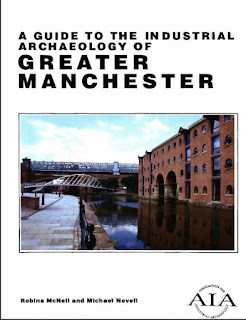This book by Robina McNeil and Michael Nevell is an excellent guide to
the many historical sites throughout Greater Manchester. Divided into
the 10 local authority areas, almost 400 locations are listed, many
accompanied by photographs and maps. This publication is well worth
delving into especially when planning a day out in the region.
A pdf version is available for download by following this link: https://industrial-archaeology.org/…/2000-Industrial-Archae…
NAVIGATION
▼
Thursday, 31 January 2019
Friday, 25 January 2019
Gow Hole or Jow Hole ?
The derivation of the name Gow Hole is unknown. The earliest mention of this hamlet, so far traced is Jawhill in 1587. In probate documents from Lichfield Joint Records Office, various spellings are to be found: Joliehole in 1665; Jollyhole in 1674; Jowhole in 1694 and 1725 and Jow Hole in Beard in 1789. Burdett's Map of Derbyshire of 1763 shows Jow Hole as does the Tithe Map of 1841. The bridge over the Goyt at the bottom of Station Road is sometimes known as Joule Bridge or Jolly Bridge. The latter name has sometimes also been given to the canal bridge in Furness Vale alonside which was the Jolly Sailor beerhouse (or Traveller's Call).
Below are extracts from the Tithe Map. Look closely at the bridge over the River Goyt and you will see the Toll House and Tollbar which once stood here. Marsh Lane was managed by the Thornsett Turnpike Trust.
Monday, 7 January 2019
DERBYSHIRE CATERPILLAR PLAGUE
SWARMS OF MARCHING INSECTS
The area affected by the Peak caterpillar plague is reported to be extending. From theKinder moorlands they are marching in the direction of Glossop and Hayfield, and near thelatter place they have invaded and spoiled the crops on some of the fields which farmers have setfireto prevent further ravages. A field of oats near Chinley has been completely ruined by the pests. They are swooping down the moors into the Goyt Valley in the direction of New Mills and Whaley Bridge and have already made their appearance on some of the farms there.
Mr H. P. Huss, the manager of Parr's Bank at Chapel-en-le-Frith, who first called attention to the plague, suggests that the gorse on the edges of the moors right along the roadsides in all directions from manchester to Sheffield, through all these places, be fired, and that tar be sprayed on each side of the affected roads two feet wide, on the Castleton road for three and a half miles long, and that the fields be heavily limed. He has also suggested that sanction be soughtfor the services, for, say, three weeks, of the local volunteers for this work.
He points out that tghe caterpillar will change in a few days into a moth, and each femal moth will in Autumn lay up to 100,000 eggs,so that the country is threatened with a far more serious plague unless serious and energetic action is taken.
Those best to judge consider that the alarming invasion is owing partly to the non-firing of the moors recently and partly to the orders for slaughtering birds that have heretofore fed on these pests and destroyed many of them, and they declare that until this ban is removed, crops wil be seriously diminished all ove the land at a time when every ounce of food is needed.
The Board of Agriculture has wired to Mr.Huss, to Mr.Boycott (clerk to the Chapel-en-le-Frith District Council), and the superintendant of police at Chapel-en-le-Frith saying that they had instructed an inspector to visit the district and advis of the caterpillar attack. They asked to be supplied at once with particulars as to the area affected, whether pasture or arable lands, and any other details obtainable.
The police authorities replied that the first they heard of the matter was on the 11th inst. It was then reported that the caterpillars existed in swarmson the moorland between Chapel-en-le-Frith and Edale, and that they were moving along the main road in the direction of Peak Forest.Inquiries made since show that practically the whole of the division if affected, chielfly on the moors.
The general opinion is that the only effective means of stamping out what is undoubtably a rapidly spreading plague over the whole country from Sheffield to Manchester is to burn up all the moors, and so destroy the pests and their nests. In the meantime, precautionary measures should be taken to prevent these vast armies from getting into the water reservoirs at Derwent, from which Sheffield, Derby, Nottingham and Leicester derive their supply; those in Woodhead Valley that supply Manchester; and those in Kinder Valley from which Stockport derives its supply,as well as the supplies to the smaller towns and villages in the area.
Burton Daily Mail 20th June 1917



